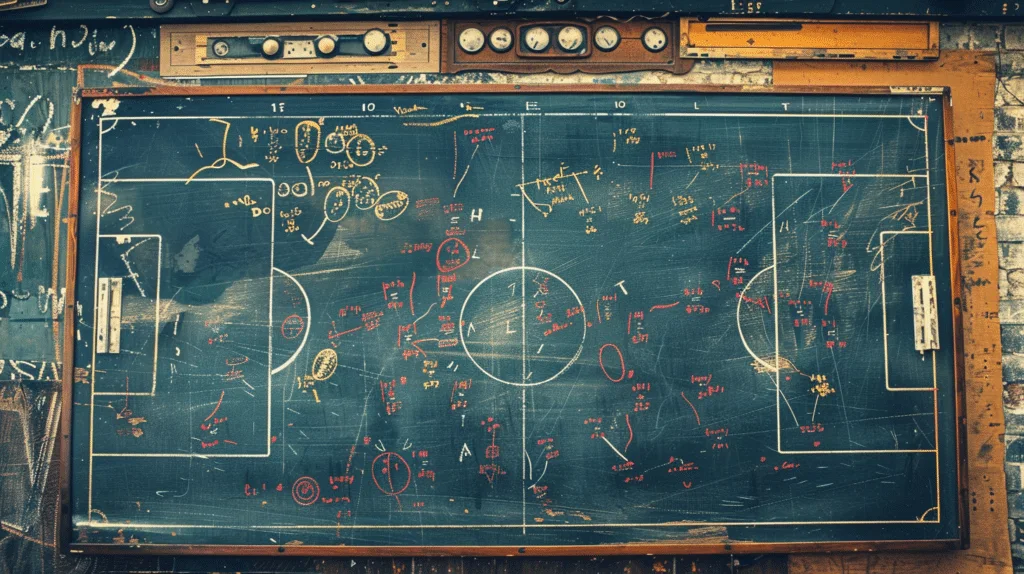The 3-4-2-1 formation, also known as the Christmas Tree formation, is a tactical system used by many successful teams throughout football history. The formation is characterized by three central defenders, four midfielders, two attacking midfielders, and one lone striker. It is a versatile formation that gives teams a solid defensive structure while providing attacking options.
The origin of the 3-4-2-1 formation can be traced back to the 1990s when Italian coach Carlo Ancelotti popularised it. Ancelotti used this formation during his time at AC Milan and achieved great success with it, winning multiple domestic and international titles. Since then, many other coaches have adopted this formation and adapted it to suit their team’s playing styles.
In terms of structure and positioning, the 3-4-2-1 formation is designed to provide a balance between defense and attack. The three central defenders form the backbone of the defense, with two full-backs providing width on the flanks. The four midfielders are split into two pairs, with one pair playing a more defensive role and the other pair playing a more attacking role. The two attacking midfielders are responsible for creating chances and supporting the lone striker upfront.
Understanding the Roles and Responsibilities of Each Position in the 3-4-2-1
In the 3-4-2-1 formation, each position has specific duties and responsibilities contributing to the team’s overall success.
The central defender’s primary role is to provide a solid defensive foundation for the team. They must be strong in aerial duels, have good positioning, and be able to read the game well. They are responsible for marking opposing strikers and intercepting passes.
The full-backs in the 3-4-2-1 formation are essential in providing width and support in attack and defense. They must overlap with the midfielders and deliver accurate crosses into the box. Defensively, they must be able to track back quickly and provide cover for the central defenders.
The four midfielders in the 3-4-2-1 formation are split into two pairs. The defensive midfielders break up opposition attacks, intercept passes, and cover the central defenders. They need to have good tackling ability, be strong in aerial duels, and have good positional awareness.
The attacking midfielders in the 3-4-2-1 formation are responsible for creating chances and supporting the lone striker. They need good vision, passing ability, and the ability to make intelligent runs into the box. They are often the link between the midfield and the attack.
The lone striker in the 3-4-2-1 formation leads the line and scores goals. They need good movement, holding up play, and clinical finishing ability. They often rely on the support of the attacking midfielders to create scoring opportunities.
One key aspect of the 3-4-2-1 formation is player versatility. Players in this formation need to adapt to different positions and roles on the field. For example, a central defender may need to push forward and provide support in attack if the team is chasing a goal. Similarly, an attacking midfielder may need to drop back and help defensively if the team is under pressure. This versatility allows teams to be flexible and adapt their tactics based on the situation.
Advantages and Disadvantages of the 3-4-2-1 Formation
Like any formation, the 3-4-2-1 has its advantages and disadvantages. Understanding these can help teams decide whether or not to implement this formation.
One of the main advantages of the 3-4-2-1 formation is its offensive flexibility. With two attacking midfielders supporting the lone striker, teams have multiple options to create scoring opportunities. The attacking midfielders can make runs into the box, play through balls to the striker, or provide crosses from broad areas. This can put a lot of pressure on opposing defenses and create scoring chances.
Another advantage of the 3-4-2-1 formation is its defensive solidity. With three central defenders and two defensive midfielders, teams can have a solid defensive structure. This makes it difficult for opposing teams to break through and score goals. The full-backs also provide cover and support in defense, making it harder for opponents to exploit the flanks.
However, one of the disadvantages of the 3-4-2-1 formation is its vulnerability to counterattacks. Teams can be exposed with only three central defenders if the opposition wins the ball and quickly transitions into attack. This requires good defensive organization and communication to prevent counterattacks.
Another disadvantage of the 3-4-2-1 formation is its reliance on player versatility. While versatility can be an advantage, it can also be a disadvantage if players are uncomfortable playing in different positions. If a team does not have players who can adapt to various roles, they may struggle to implement this formation effectively.
Key Principles of Play in the 3-4-2-1 Formation
Key Principles of Play in the 3-4-2-1 Formation
Description
Compactness
The team should maintain a tight formation to limit the space for the opposition to play in.
Width
The wing-backs should provide width in attack and defense to stretch the opposition and create space for the forwards.
Pressing
The team should press high up the pitch to win the ball back quickly and prevent the opposition from building attacks.
Counter-attacking
When the team wins the ball back, it should quickly transition from defense to attack, using the pace of the forwards to catch the opposition off guard.
Rotation
The two attacking midfielders should rotate positions to create confusion for the opposition and space for each other.
Overlapping runs
The wing-backs should make overlapping runs to create overloads in wide areas and provide crosses for the forwards.
Quick passing
The team should use quick, one-touch passing to move the ball up the pitch and create chances.
Defensive solidity
The team should be well-organized and disciplined in defense to prevent the opposition from creating chances.
To succeed in the 3-4-2-1 formation, teams must adhere to certain fundamental principles of play.
One key principle in the 3-4-2-1 formation is possession. With four midfielders, teams have numerical superiority in midfield and should look to dominate possession. This allows them to control the game and dictate the tempo. Possession also helps to create scoring opportunities and limit the opposition’s chances.
Another key principle in the 3-4-2-1 formation is quick transitions. When the team wins the ball, they should transition quickly from defense to attack. The attacking midfielders and lone strikers must make intelligent runs and exploit any spaces the opposition leaves. Quick transitions can catch the opposition off guard and create scoring opportunities.
The defensive organization is also crucial in the 3-4-2-1 formation. With three central defenders, teams must be well-positioned and communicate effectively. This helps to prevent gaps in defense and makes it harder for the opposition to break through. The defensive midfielders also play a key role in providing cover and support for the central defenders.
The Importance of Communication and Coordination in the 3-4-2-1 Formation
Communication and coordination are essential in the 3-4-2-1 formation. With multiple players playing in different positions and roles, players need to communicate effectively on the field.
Communication helps players to understand their roles and responsibilities, as well as coordinate their movements. For example, the central defenders need to communicate with each other to ensure that they are well-positioned and organized. They need to know when to step up and drop back and who should mark which opposing player.
Coordination is also crucial in the 3-4-2-1 formation. Players need to coordinate their movements and work together as a unit. For example, the attacking midfielders must coordinate their runs and movements with the lone striker to create scoring opportunities. The full-backs also need to coordinate their movements with the midfielders to provide support in attack and cover in defense.
Teams that have mastered the 3-4-2-1 formation can show examples of successful communication and coordination. For example, under Carlo Ancelotti, AC Milan was known for its excellent communication and coordination. The players understood their roles and responsibilities and worked together seamlessly on the field, allowing them to dominate games and achieve great success.
Effective Training Drills for the 3-4-2-1 Formation
To effectively implement the 3-4-2-1 formation, teams must incorporate specific training drills focusing on player positioning and movement.
One effective training drill for the 3-4-2-1 formation is the possession game. In this drill, teams are divided into two groups, with one group trying to maintain possession of the ball while the other group tries to win it back. This drill helps players understand their roles and responsibilities in the formation and improve their passing and movement off the ball.
Another effective training drill for the 3-4-2-1 formation is the transition game. In this drill, teams practice transitioning quickly from defense to attack and vice versa. The coach can set up different scenarios to simulate game-like situations, such as winning the ball in midfield or defending a counterattack. This drill helps players improve their decision-making and coordination in transition moments.
Incorporating game-like scenarios in training is important when working on the 3-4-2-1 formation. This helps players understand how to apply the principles of play in real-game situations. For example, teams can practice attacking movements and combinations in the final third or work on defensive organization in different scenarios.
Adjusting the 3-4-2-1 Formation to Counter-Opponent Strategies
One advantage of the 3-4-2-1 formation is its flexibility, which allows teams to adjust their tactics based on their opponents’ strategies.
For example, if the opposition plays with a lone striker, the team can adjust by pushing one of the central defenders forward to provide extra cover in midfield. This helps to nullify the opposition’s attacking threat and gives the team more control in midfield.
On the other hand, if the opposition is playing with two strikers, the team can adjust by dropping one of the attacking midfielders deeper to provide extra defensive cover. This helps to prevent the opposition from overloading the central defenders and creates a more balanced defensive structure.
Examples of successful adjustments in the 3-4-2-1 formation can be seen in real-world matches. For instance, during the 2018 World Cup, Belgium used the 3-4-2-1 formation and adjusted based on their opponent’s strategies. In their quarter-final match against Brazil, they dropped one of the attacking midfielders deeper to provide extra defensive cover and nullify Brazil’s attacking threat. This adjustment proved successful as Belgium won the match 2-1.
Analysing Real-World Examples of Successful 3-4-2-1 Tactics
Many successful teams have used the 3-4-2-1 formation and implemented key tactics and strategies.
One example is Antonio Conte’s Chelsea team during the 2016-2017 season. Conte used the 3-4-2-1 formation and implemented a high-intensity pressing game. His team would press aggressively when out of possession, forcing turnovers and quickly transitioning into attack. This tactic helped Chelsea win the Premier League title that season.
Another example is Jurgen Klopp’s Liverpool team during their successful Champions League campaign in 2018-2019. Klopp used the 3-4-2-1 formation and focused on quick transitions and counterattacks. His team would defend compactly and then quickly transition into attack when they won the ball. This tactic helped Liverpool win the Champions League title that season.
Analyzing these real-world examples can provide valuable insights into the key tactics and strategies used in the 3-4-2-1 formation. It can also inspire teams to experiment with different tactics and find what works best for their playing style.
Common Mistakes to Avoid When Implementing the 3-4-2-1 Formation
When implementing the 3-4-2-1 formation, there are common mistakes that teams should avoid to maximize their potential.
One common mistake is not having comfortable players playing in different positions. As mentioned earlier, player versatility is essential in the 3-4-2-1 formation. If a team does not have players who can adapt to various roles, they may struggle to implement this formation effectively. Teams must identify players with the necessary skills and attributes to play in different positions.
Another common mistake is not emphasizing defensive organization and communication. With three central defenders, teams must be well-positioned and communicate effectively. This helps to prevent gaps in defense and makes it harder for the opposition to break through. The defensive midfielders also play a key role in providing cover and support for the central defenders.
Teams should also avoid being too predictable in their attacking movements. With two attacking midfielders supporting the lone striker, teams have multiple options to create scoring opportunities. Teams need to vary their attacking movements and keep the opposition guessing. This can be achieved through intelligent runs, quick passing combinations, and overlapping runs from the full-backs.
Mastering the 3-4-2-1 Formation for Success on the Field
In conclusion, the 3-4-2-1 formation is a versatile tactical system that can provide teams with offensive and defensive flexibility. Understanding the roles and responsibilities of each position and the key principles of play is crucial for success in this formation. Communication and coordination are also important in maximizing the formation’s potential.
By incorporating effective training drills and adjusting the formation to counter opponent strategies, teams can master the 3-4-2-1 formation and succeed on the field. Analyzing real-world examples of successful tactics and techniques can provide valuable insights and inspiration for teams looking to implement this formation.
While there may be challenges and mistakes along the way, with practice and patience, teams can master the 3-4-2-1 formation and unlock its full potential. Experimenting with different tactics and strategies is important to find what works best for the team’s playing style. So, go ahead and give the 3-4-2-1 formation a try, and see how it can elevate your team’s performance on the field.
If you are a football enthusiast looking to delve deeper into the intricacies of tactical formations, you’ll want to check out this insightful article on the 3-4-2-1 formation. This formation has gained popularity recently due to its ability to provide a solid defensive structure while allowing for fluid attacking movements. To learn more about the strengths and weaknesses of the 3-4-2-1 formation, head over to the Kicka Football website and read their comprehensive analysis. You won’t want to miss it!






